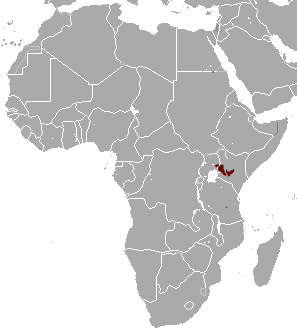Jackson's mongoose facts for kids
Quick facts for kids Jackson's mongoose |
|
|---|---|
| Conservation status | |
| Scientific classification | |
| Genus: |
Bdeogale
|
| Species: |
jacksoni
|
 |
|
| Jackson's mongoose range | |
The Jackson's mongoose (Bdeogale jacksoni) is a type of mongoose. It lives in mountain forests in Kenya, Uganda, and Tanzania. This animal seems to be quite rare. Because of this, it has been listed as Near Threatened since 2008. This means it might become endangered in the future.
Jackson's mongooses have long, thick fur that is a mix of black and white. Their cheeks, throat, and the sides of their neck are yellowish. Their legs are dark brown or black, and their bushy tail is white. They are large mongooses, growing to more than 50 centimeters (about 20 inches) long. They usually weigh between 2 and 3 kilograms (about 4.4 to 6.6 pounds). These mongooses are mostly active at night or during twilight hours. They might live alone. They eat small rodents and insects.
Contents
About Its Name
The scientific name for Jackson's mongoose is Galeriscus jacksoni. This name was first suggested by Oldfield Thomas in 1894. He named it after Frederick John Jackson, who found the animal's skin in Kenya. The specific place where it was found is called Mianzini in Maasailand. This area is very high up, about 2,400 meters (8,000 feet) above sea level.
Later, in 1916, Reginald Innes Pocock decided that this animal was a type of mongoose. He placed it in the genus Bdeogale. This means its full scientific name became Bdeogale jacksoni. Most scientists today agree with this classification.
What It Looks Like
Jackson's mongoose has silvery-grey fur. Its cheeks, throat, and the sides of its neck are yellowish. The top of its head is a grizzled grey, but its snout and chin are brownish-white. It also has a few brown hairs around its eyes. Its round ears are grey on the outside and yellowish inside.
The mongoose's belly is light grey. Its legs are blackish-brown or black, and the very tip of its tail is white. The hairs on its back are about 20 millimeters (0.8 inches) long. Each hair has black and white rings. Underneath, it has a thick, woolly layer of fur.
Its snout is blunt, and it has a large, hairless nose area. The upper lip is divided by a groove. Both its front and back feet have only four toes. The bottoms of its feet are bare, and its claws are thick and strong.
This is a large mongoose. Its head and body can be from 50.8 to 57.1 centimeters (20 to 22.5 inches) long. Its bushy tail is about 28.3 to 32.4 centimeters (11 to 12.8 inches) long. Its back foot measures 8.6 to 10.8 centimeters (3.4 to 4.3 inches). Its ear is small, about 2.3 to 3.5 centimeters (0.9 to 1.4 inches) long. It weighs between 2 and 3 kilograms (4.4 to 6.6 pounds).
Jackson's mongooses have 40 teeth in total. This includes three incisors, one canine, four premolars, and two molars on each side of their jaw. Young mongooses that are old enough to have babies might be smaller than adult ones. You can tell a Jackson's mongoose apart from a black-footed mongoose because it has much longer fur, especially on its tail. It also has yellowish colors on its neck and throat.
Where It Lives
Jackson's mongoose lives in central and southern Kenya and southeastern Uganda. It has been seen in places like the Aberdare Range, Mount Kenya, and the Mount Elgon mountains. It lives at different heights, from 300 meters (about 980 feet) to 3,300 meters (about 10,800 feet) above sea level.
It makes its home in lowland forests, bamboo forests, and mountain forests. In Tanzania, it was first seen in the Udzungwa Mountains in 2002. This sighting happened in the Matundu Forest.
Behaviour and Life Cycle
Jackson's mongoose is mostly active at night (nocturnal) or during dawn and dusk (crepuscular). In the Udzungwa Mountains, most pictures of them from camera traps were taken at night. It is thought that they usually live alone. However, they have also been seen in pairs and sometimes in groups of four. We don't know much about how they have babies or raise their young.
They probably hunt often in the thick plants around swamps. Jackson's mongooses are omnivores, meaning they eat both plants and animals. Scientists studied 40 samples of their poop from the Aberdare Mountains. These samples showed that they eat many different things.
Their diet includes army ants, beetles, weevils, millipedes, and caterpillars. They also eat rodents like Otomys, Dasymys, and Praomys. Sometimes, they eat snails, lizards, and even snake eggs. Young mongooses mostly eat rodents and insects. Eating army ants might be a new way they have learned to find food.
Protecting Jackson's Mongoose
Jackson's mongoose lives in separate groups and seems to be rare. It has been listed as Near Threatened on the IUCN Red List since 2008. This is because its numbers are thought to have gone down in the last 10 years. The main reason for this is the destruction of its habitat, especially forests.
This mongoose lives in several protected areas. These include Aberdare National Park, Mount Kenya National Park, and Udzungwa Mountains National Park. Scientists also think it might live in Mount Elgon National Park. It could be found in more places than we currently know. Experts have suggested fully protecting forests next to the Udzungwa Mountains National Park. They also recommend looking for the mongoose in other forests that depend on groundwater in the area.


